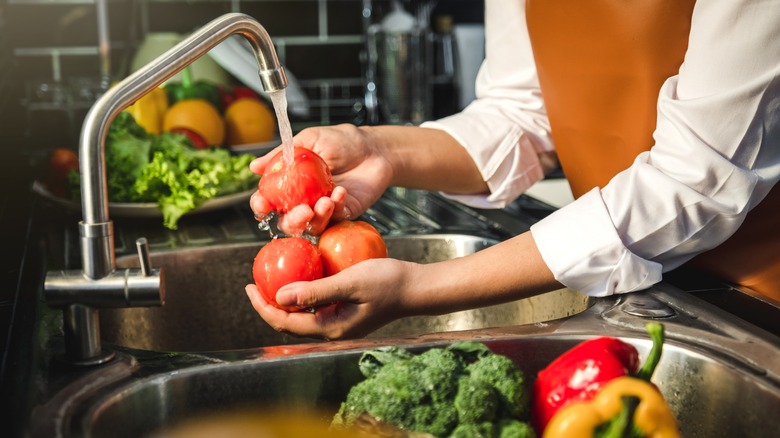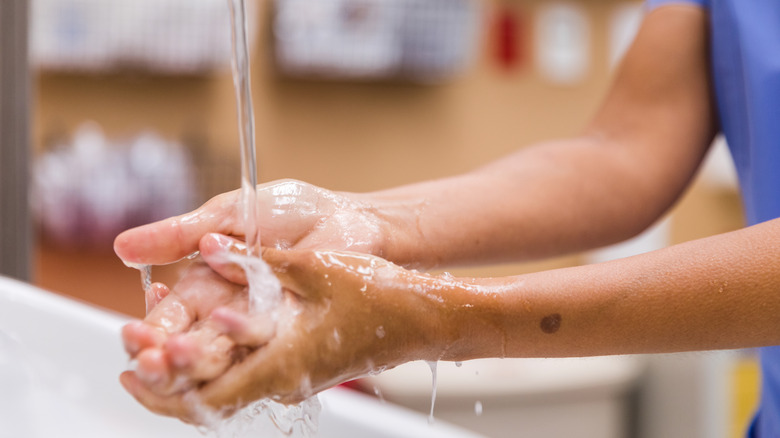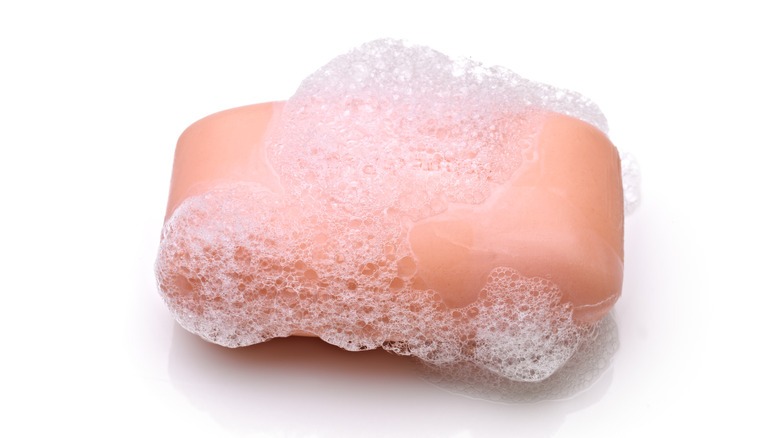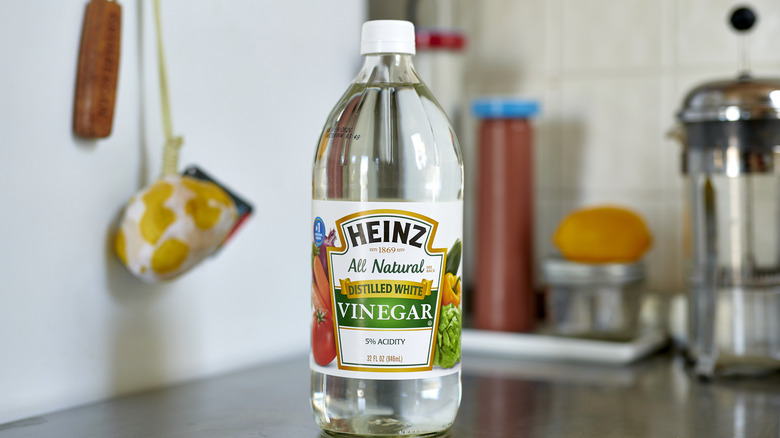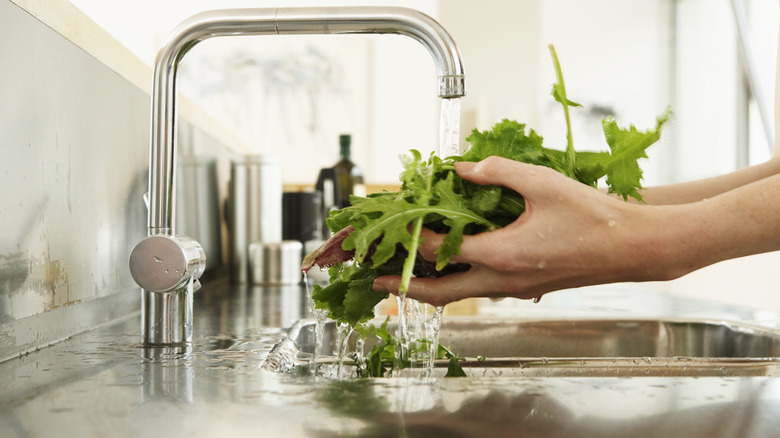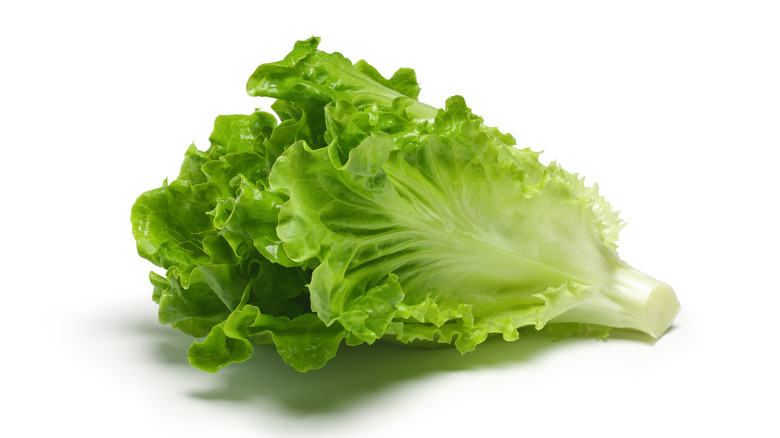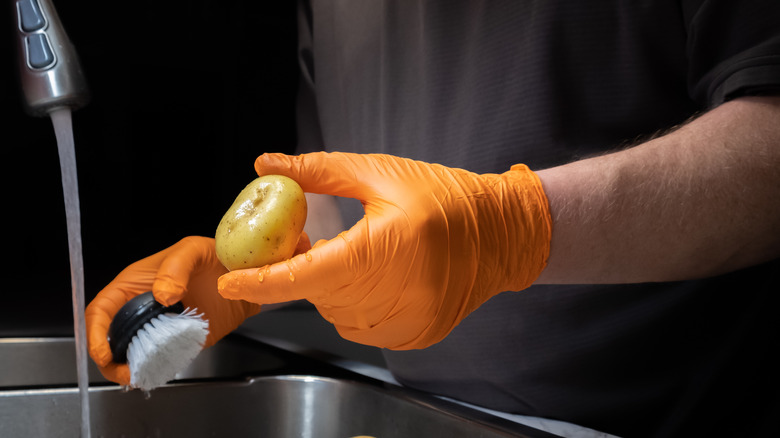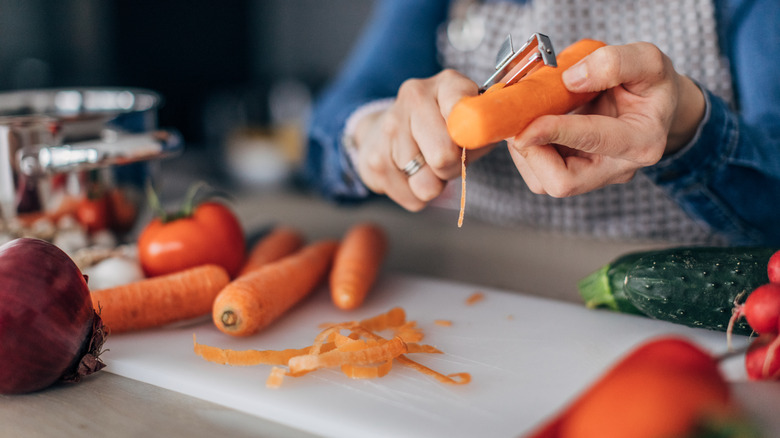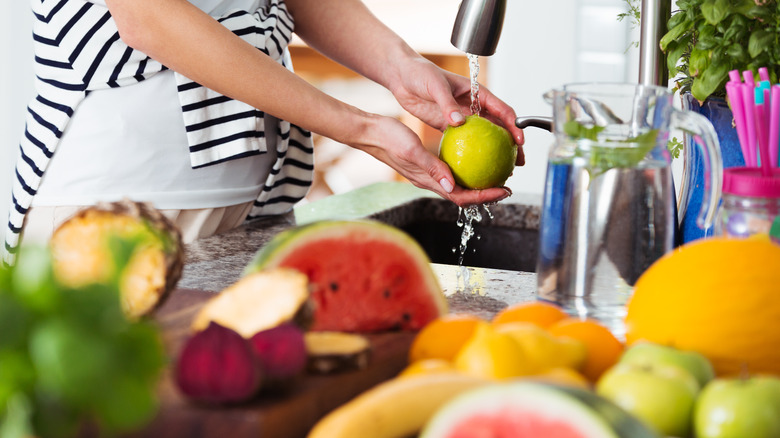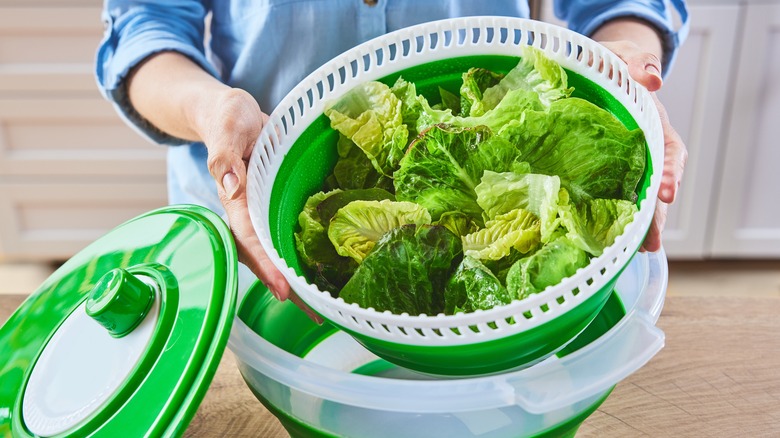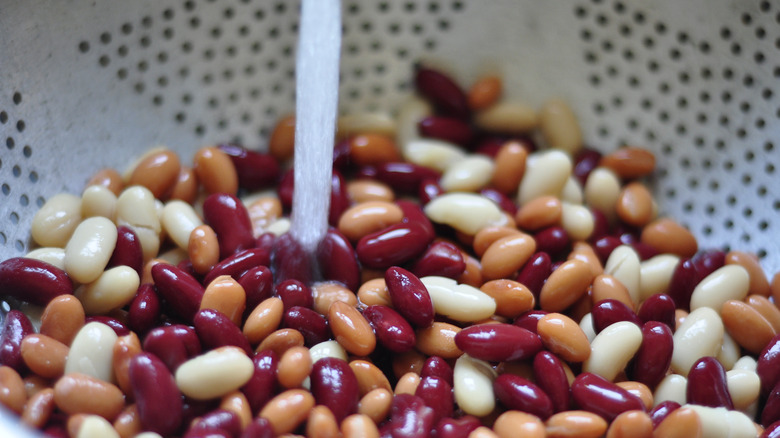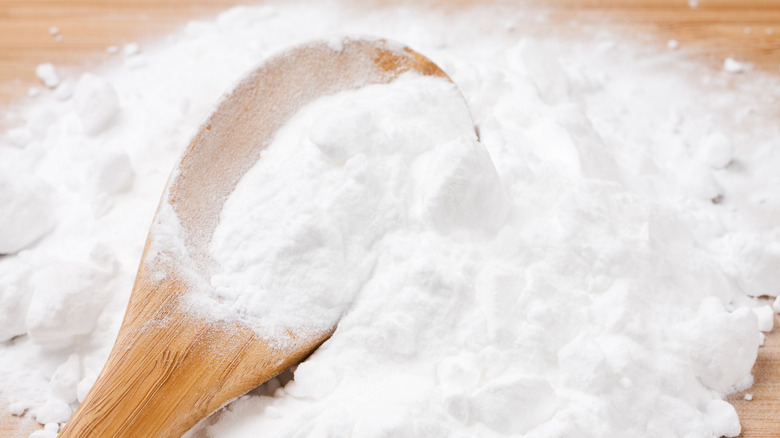11 Mistakes Everyone Makes When Washing Fruits And Vegetables
Fruits and vegetables are two of the most important parts of a healthy diet. They provide vitamins and nutrients, can help with weight management, and some of them (especially the orange and yellow ones) can even help protect your eyesight. Unfortunately, though, there is one situation in which fruits and vegetables can do more harm than good, and that is when they aren't properly washed.
According to the Centers for Disease Control and Prevention (CDC), the safest way to eat fruits and vegetables is cooked, with washed being the next best thing. This is because produce can carry germs and bacteria that can cause illnesses like listeria, salmonella, and E. coli – which obviously aren't a part of that healthy diet we mentioned. Washing can go a long way toward eliminating any harmful substances on your fruits and veggies, but only if you do it the right way. There are many mistakes being made while washing produce that can lead to illness, but luckily we're here to clear things up. Avoid the following mistakes and you'll have nice, clean fruits and vegetables that will help you feel better, not worse.
1. Not washing your hands first
There are many hands that can contaminate your produce before it reaches your kitchen. During the growing phase, it can be touched by the tiny hands (or feet, or other body parts) of animals and insects. Then there are the hands of the workers at the farm where it is produced, who may or may not have washed those hands after touching dirty or dangerous substances. Then there are the hands of the people who sort the produce, and those who ship the produce, and those who put it on the shelf at the store, not to mention those customers at the store who pick it up and put it back. Before you eat it and even before you wash it, though, there is one more set of hands that comes into contact with your produce: yours.
Washing your fruits and vegetables will help rid them of any germs that may have been transferred to them along the way from their plants to your home, but if you don't wash your own hands before washing them, you could potentially be adding more germs to the mix. The FDA recommends washing your hands thoroughly and with soap, preferably for 20 seconds, before washing your produce. You should also wash your hands afterwards to avoid spreading any germs around the house that may have been washed off the fruit.
2. Using soap
Okay, so we know you should definitely wash your hands with soap and water before washing your fruits and vegetables. So it would make sense that you should wash your produce with soap and water too, right? Very wrong!
While you may have seen commercial produce washes at the store, these, along with any other soap you may have at home, are a big no-no when it comes to washing fruits or veggies. Sure, maybe you might kill the germs that are present, but you may also make yourself or your family sick anyway. Instead of bacterial contamination, you are now dealing with chemical contamination.
It is difficult to wash away all the soap from produce, and any remnants that are left behind will be ingested when you eat it. This can lead to vomiting and diarrhea, which, we're sure, is exactly what you were trying to avoid by washing it in the first place. While it may not feel like "enough," all you need to use when washing fruits and vegetables is clean water: no soaps or detergents are required.
3. Using vinegar
Even if you know that using soap to wash produce is a bad idea, you may still be looking for something else to get that produce squeaky clean. So, maybe you turn to an old favorite for household cleaning: vinegar. Different types of vinegar can do everything from whitening clothes to getting the smell of cat urine out of carpet, but one thing it cannot do well is clean and decontaminate food.
In order for vinegar to be effective at killing bacteria on your vegetables or fruit, they would need to be soaked in it for a long period of time. The issue with this is that, if those vegetables and fruit remain in the vinegar for long enough to kill the pathogens, they will also remain there long enough to get pickled. The vinegar will change the quality of the food, turning it into something you did not intend to create (who wants pickled kale?). The best way to clean your produce is to use simple, clean water. That's really all you need.
4. Not using running water
This is a mistake that is very widespread. Many believe that soaking produce in clean water, then rinsing it, then soaking it some more is the best way to get it clean, but that isn't actually true. The best way to wash produce is under running water, because this allows the dirt and germs to drain off as you wash instead of sitting with them in the water.
This cleaning method is especially important for leafy greens like kale, lettuce, spinach, and bok choy. The leaves of these vegetables have many grooves, ripples, and veins under and between which dirt and germs can hide. In fact, you may have even noticed that the individual leaves of your head of lettuce looked visibly dirty before you cleaned it. This is because they grow close to the dirt and, as such, have a tendency to trap that dirt between the leaves – along with pathogens that you can't see. Washing each leaf individually under running water may take a bit more time and effort than leaving a handful of them to soak, but it is the best way to eliminate the germs and other substances that may be on them.
5. Not removing the outer leaves
Both lettuce and cabbage grow close to the ground, so it is easy for them to get covered in, not just soil, but also the bacteria that grows around the irrigation system that runs through the ground close to them. Washing is enough for the interior layers of lettuce or cabbage leaves, but it is best to just remove the outer layer completely. This layer has had the most contact with the ground and with pathogens (and pesticides, and the hands of everyone who touched it along the way to the supermarket), so it is, therefore, the dirtiest.
Once the outermost leaves are removed, rinse the rest of the leaves under running water. Keep rinsing until you can't see any more dirt on them, and they should then also be free from any bacteria that may have been on them as well. It is then a good idea to put them in a salad spinner and spin until the excess water has been removed and the lettuce is dry. This keeps other bacteria from growing on it and prevents it from spoiling.
6. Forgetting to scrub
If you have ever seen a raw potato, you will know that they are very dirty little things. They grow under the ground, and you can tell that by the amount of soil that is present on the peeling, even after they have gone through the process of getting prepared for sale at a grocery store. That's why it is important to, not just rinse them gently under some running water, but to really put some elbow grease into your cleaning.
Hard, firm produce like potatoes, carrots, cucumbers, avocados, and melons should not just be rinsed, but scrubbed. You can do this with your hands, but it is better to use a clean vegetable brush. Don't rub so hard that the skin comes off, but do scrub them thoroughly. The dirt on potatoes is often visible, but the listeria germs that get inside the grooves in the peel of fruits like cantaloupes, for example, are not. A vegetable brush can help eliminate both the visible and invisible contamination, and is a small but great investment.
7. Peeling before washing
Why wash a peel you're just going to take off? Because the peeling process can spread germs to the interior part of the fruit, that's why. You should always wash your fruit before peeling it, and there are no exceptions to this rule. Otherwise, the dirt and/or bacteria on the skin gets on the knife or kitchen tool you are using and gets transferred to the fruit itself as you peel it. It is for this reason that many people wash carrots or potatoes, peel them, and then rinse them again, just to be extra sure that there is no dirt on the inner part of the food.
This applies to fruits like oranges as well, which you can peel even without a knife. You never know what pesticides, dirt, or other substances came into contact with your fruit or vegetables before they got to you, so it is better to be safe than sorry.
8. Washing your fruits and vegetables too soon
Since we know that fruits and vegetables may be harboring germs and other unsavory substances, it seems like it would be a good idea to wash them as soon as you bring them home. However, this is not ideal. Washing your produce too soon puts it at a higher risk for spoilage because some of the water you use to clean it remains on the fruit or vegetable and encourages bacteria to grow as it sits on your counter or in your fridge.
The best thing to do is wash your produce only when you are getting ready to eat it. This may mean, for instance, washing only the amount of lettuce you know you'll need for your side salad tonight and leaving the rest in the fridge, unwashed, until you need it. If you do have any clean lettuce leftover, store it separately from the unwashed lettuce and try to eat it fairly quickly, so as not to give it time to spoil.
9. Not drying your produce before putting it in the fridge
Alright, we get it: to clean vegetables and fruit, we have to rinse them under running water. But then what? If you are going to be storing your washed produce for any length of time, you need to make sure that it is dry. Any dampness left behind after washing can enable bacteria to grow, no matter how thoroughly you cleaned the food. This bacterial growth then makes the produce go bad, which can make you as sick as you might have gotten if you never washed it at all.
If you are washing leafy greens, use a salad spinner to spin out the excess moisture. If you don't have one, pat the leaves dry with a clean dish towel and let them air dry on a (dry) towel on the counter. If you are washing other fruits and veggies like apples, blot away excess moisture with a paper towel and try to eat them as soon as possible.
10. Washing beans without a colander
The best way to wash any kind of fruit or vegetable is to do so under the faucet, letting the water run down over the fruit and into the drain. But what if you are washing something like beans? It is impossible to rinse a handful of beans without losing some in the sink, but we already know soaking isn't the best idea either. So, what's a bean-washer to do? Grab their colander, that's what!
Beans and other similar things like peas, chickpeas, lentils, and blueberries can be placed in a colander and washed under running water. This lets the clean water pass over them and allows the residue that is washed away to go down the drain immediately. Be sure to agitate them with your (washed) hand as you rinse them, though, so that you ensure that every bean gets clean. Once you are finished rinsing, turn off the water and let the remaining moisture drain out of the colander. Then voila — you're ready to cook your beans.
11. Not considering using baking soda to remove pesticides
We have spent much of this article explaining how the only thing you need to wash vegetables is clean water, but there may be one exception to this rule. While research on this topic is not widely available, studies like the one carried out by a team in China suggest that soaking your produce in baking soda (also known as sodium bicarbonate) might help eliminate certain types of pesticide residue more effectively than tap water. This effect was only reported for spinach, however, so its effectiveness may depend on the type of produce you are cleaning as well as the type of pesticides used to clean it.
Pesticides are a concern for many consumers, because they are substances sprayed on plants during their growing process in order to kill insects, fungus, and other unwanted things. Even produce from organic farms contain pesticides, although in this case they are typically derived from natural materials instead of chemical ones. It should be noted, however, that pesticide residue is not usually harmful to one's health unless it is consumed in large amounts. As such, thoroughly rinsing produce with water should be enough to keep you safe, but a baking soda soak consisting of only water and a small amount of baking soda followed by a thorough rinse won't hurt you.
